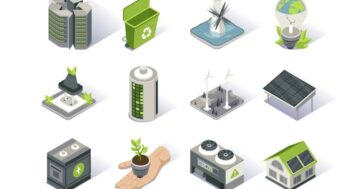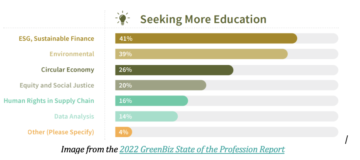Climate tech has been capturing headlines all year. And investment in climate tech increased tremendously between 2015 and 2020. In late October, two separate reports showed that climate tech funding reached $30 billion for the year.
"It is my belief that the next 1,000 unicorns — companies that have a market valuation over $1 billion — won’t be a search engine, won’t be a media company, they’ll be businesses developing green hydrogen, green agriculture, green steel and green cement," BlackRock CEO Larry Fink said recently.
During this year’s VERGE 21 event from GreenBiz Group, climate tech was front and center. Twelve students and young professionals were able to join the conversation — during keynotes and breakout discussions — via the Emerging Leaders program, sponsored by Deloitte.
"VERGE Emerging Leaders program is important to Deloitte because it lays at the intersection of our ambition to drive responsible climate choices and our commitment to advance equity," said Kwasi Mitchell, chief purpose officer of Deloitte U.S. "We are thrilled to support a program that helps create the next generation of leaders in sustainable business."
With all of that in mind, we asked the VERGE 21 cohort of Emerging Leaders to answer the following question: What climate tech do you feel deserves more investment?

Daniel Gonzalez
Product Engineer at Esri
There was a lot of climate tech at VERGE 21. From new and improved methods of renewable energy storage to e-mobility in last mile delivery, climate tech was top of mind. While there were a lot of climate tech ventures that caught my eye, the area that was most interesting to me was sustainable aviation fuel (SAF). Aviation contributes significantly to climate change but has historically been an industry that is difficult to decarbonize. While SAF may not be the final solution, it does reduce emissions and can serve as a stepping stone while new carbon neutral aviation technologies are being developed.
SAF is a step towards a more carbon-free economy. But there were other technologies at VERGE 21 worth mentioning: tools for monitoring forest offsets, platforms focused on organizing ESG and supply chains, and software that educates the public on climate change solutions.
At VERGE 21 there was a sense of hope. Most people were aware of the enormity of climate change, but their solutions were also just as grand.

Angie Kim
Sustainability Coordinator at the State University of New York
Climate-smart agricultural technology deserves more investment, resources, and attention. Agriculture is a major part of the climate problem. Food production accounts for 37 percent of global greenhouse gas (GHG) emissions, consumes 30 percent of all energy produced and uses 70 percent of freshwater. Nearly a quarter of all Earth’s soil is severely damaged by unsustainable farming practices that decrease yield and productivity, impacting the well-being of our farmers. Modern industrial farming is connected to myriad environmental burdens, including deforestation, biodiversity loss, water pollution and particularly climate change. We must transform our agriculture and farming methods in order to protect our soil, sequester carbon and mitigate climate change.

Yara Marin
Interior West Regional Director at Vote Solar
We are seeing massive investments when it comes to decarbonizing the power grid but there is still plenty of work that needs to be done in order to significantly reduce emissions and save the very place we all call home. We are in the midst of a climate emergency, and it cannot wait. However, one thing remains certain; we are not moving forward fast enough. We cannot reach a 100 percent clean energy future unless we chart a sustainable path forward that is inclusive and reflective of all Americans. We must also do this through a process that is just and equitable. We need solutions at the scale needed to meet the climate crisis. This is our opportunity to hone solar energy’s full potential and pair it with storage in order to ensure a flexible and resilient system that meets our nation's electricity needs.
Low-wealth communities and communities of color experience higher rates of energy poverty. We need to invest heavily into these communities and ensure that they have access to energy efficiency programs, community solar, and solar storage alternatives that would reduce energy burdens for these households.
By investing into financing solutions and education we are putting systems in place that will bring a tremendous amount of power to customers while allowing them the freedom to make better choices and to have better control of their electricity use. This can ensure a just redistribution of power and resources for all.

Blerinda Veliu
Fulbright Scholar, Founder and CEO at BOTANIC LLC
VERGE 21 was the right event at the right time. Before attending this conference, I would not have known the actual size of the role that tech plays when it comes to sustainable development and climate change. However, today while I reflect upon my experience, studies and the sessions I attended during VERGE 21, I think climate tech is a crucial enabler and mitigator in reducing the GHG emissions and meeting the 2030 Paris Agreement targets of dropping to 1.5 degrees Celsius global temperature. Considering the current climate emergency, carbon capturing technologies are playing a crucial role on mitigating climate change. Hence, I believe that more attention investment-wise would contribute on increasing and inspiring innovation and creation of more advanced technologies in this area. What caught my attention during VERGE 21 is the variance in carbon capturing climate tech, the applied technology in different sectors such as agriculture, forestry, food waste and other high GHG-emission producing industries, showed the enormous potential that climate tech has on tackling emissions from many angles. In the future I see myself working towards bringing such technology in my country Kosovo, and in other developing countries around the world.

David Yosuico
Client and Field Manager for Gemini Energy Solutions
I think inclusive utility financing programs merit more investment. In inclusive utility financing programs, like tariff on-bill or Pay As You Save, the utility arranges for the upfront cost of investment for energy efficiency upgrades for its customers. By doing so, the utility reduces the demand for energy within its service territory and therefore the cost of procuring and distributing energy. The cost of the upgrades is recovered through a charge on the customer bill that is much less than the energy savings. This type of program assigns the tariffed charge for cost recovery to a location, not an individual customer, so renters are eligible, and it does not require a credit check, reducing barriers to realizing energy savings. You can read more about inclusive utility financing here (PDF).
Two companies that complement inclusive utility financing programs are Recurve and Gemini Energy Solutions (shameless self-plug). Recurve is a Bay Area startup who oversees the DemandFlex Market, which compensates implementers for providing total resource cost (TRC) savings to the utility. Finding ways to shift energy demand to times when renewable energy production is high, and reducing demand during high-polluting hours and when it costs a lot of resources for the utility to procure energy seems to me like one of the most effective ways to reduce our greenhouse gas emissions.
Gemini Energy Solutions is a Black-owned energy efficiency startup which specializes in providing energy audits and inclusive financing for small businesses, rural areas, and communities of color. Gemini uses building sensors and data-driven software to produce energy audits at an affordable price, providing cost-effective solutions that empower historically underserved populations and bring us closer to a zero-emissions future with 100 percent participation.

Jazmin Rodriguez
Marketing Coordinator, Hot Purple Energy
Consumption is inevitable whether it be meat, water, power or daily products with plastic packaging, but technologies providing alternative options are slowly making their way into markets and in some sectors they have already made substantial impacts like the huge power shift we’ve seen with solar and wind. However, the transportation industry continues to be the largest emitter of carbon and other greenhouse gases in the U.S. and that’s why we need to be prioritizing innovation and investments in this area, especially in the commercial sector. Alternative and renewable fuel sources have recently gained more traction, especially in the aviation sector with SAF, which can provide a 70 to 80 percent carbon dioxide reduction in comparison to regular fuel according to SkyNRG, one of the featured companies at VERGE 21. Although the last year and a half hit the airline industry pretty hard economically as a result of the pandemic, we have begun to see commercial flights resume and some travelers have gone back to business as usual. While SAF is already proving to have a lot of potential, there are still hurdles that producers are facing that include location of production facilities, fuel transportation and the competitive market prices of regular jet fuel — SAF costs three to four times more. SAF could pave the way for more environmentally friendly travel, could put us on a faster track to reaching carbon reduction goals, and will make us more resilient in the long run.

Lindsay Shigetomi
Climate Corps Fellow
Attending VERGE 21 as an emerging leader gave me a renewed sense of optimism and reinforced my role in addressing the climate crisis.
The challenges of the climate crisis are urgent and so large. I found my sense of optimism and agency waning — particularly in this distanced COVID atmosphere. At VERGE, sessions demonstrated technologies deployed around the globe across all sectors, with increasing integration to address the cross-sectoral sustainability needs. These technologies are the "how" in addressing the climate crisis. However, VERGE reinvigorated my personal sense of agency because it connected me with the VERGE community.
The sustainability community I connected with at VERGE is a critically important "who" in building a sustainable future and we are increasingly dedicated to ensuring equity in the sustainable future we are building. For centuries, technological advancements have fueled economic growth. However, these historical advancements have been costly because equity has not been a central consideration in their deployment. VERGE demonstrated we are at a critical turning point — the "who benefits" is increasingly a concern as we deploy sustainability technology. At VERGE, I saw Indigenous practices, youth voices and BIPOC leaders uplifted and celebrated equally with conventionally powerful voices from the public and private sectors.
At VERGE, I connected with sustainability leaders building a powerful movement. We have difficult work ahead of us, but we can address the climate crisis. We must do this by investing our time and efforts into building collaboration across sectors and in our communities to ensure that everyone has equal outcomes in our sustainable climate future.

Mariatu Santiago
Graduate Research Assistant, University of Michigan
There are so many climate technologies that deserve attention. I think technologies that monitor carbon emissions in a company’s supply chain deserve more investment. For instance SupplyShift, a platform that participated in this year’s Accelerate at VERGE 21, monitors a company’s supply chain so that they can have more responsible sourcing practices. This type of technology is important since about 90 percent of a company’s GHG emissions comes from their supply chain. With supply chain management software like SupplyShift, companies can proactively monitor their negative impact and hopefully, devise resilient solutions. I also think that these web platforms will be more important as governments and consumers continue to demand that companies make meaningful improvements to mitigate their impact on biodiversity, the air, water and land, to name a few. Although it is not mandatory to report Scope 3 emissions, companies will need to tackle these if they want to transform their impact. As was noted by multiple people at this year’s VERGE conference, there is an urgent need to transform our relationship with the environment. Companies will need to think deeper about how they interact with the people, places and things required to make their products if they want to be serious about their impact.

Yifan Wang
EDF+Business Resilient Food and Forests Fellow at Environmental Defense Fund
I believe climate tech investors should pay more attention to the food, agriculture and land use sector in general, and particularly in nascent solutions like alternative proteins and dairy. While the sector has been gaining attention over the past years and closed 30 percent of the total climate tech venture deals in 2020, it is still an underinvested space as the sector is the largest contributor of methane emissions (46 percent). At the moment, alternative protein and dairy products on the market only represent 2 percent of the global meat and dairy industry, and thus have huge potential in reducing methane emissions. By reducing the land required to raise livestock and grow animal feed, global diet shift towards alternative proteins could potentially sequester 300 to 550 gigatons of CO2, the amount of carbon remains in the 1.5C budget. Some of the food tech VCs I have been keeping an eye out include S2G Ventures, AgFunder, Lever VC and Blue Horizon Ventures.

Uchitta Vashist
Metallurgist, Junior at SGS
Future sustainable technologies (FST) such as renewable energy technologies will make use of indium (In), germanium (Ge), tantalum (Ta), PGM [platinum group metals] tellurium (Te), cobalt (Co), lithium (Li), gallium (Ga) and RE (rare earths). These are also classified as "green minor metals," which are the basis for cleaner technology innovation. While mining of these critical metals has significant waste footprint and environmental impact using presently established technologies, additional investment on research and development of closed-loop recycling systems for critical metal extraction is crucial for successful global energy transition. With the current rate and state of mining, the production of these metals is bound to cause more environmental damage than recovery.
Numerous promising start-ups are emerging in this domain such as Nth Cycle, which received $3.2 million in seed funding led by Boston-based clean energy venture capital company Clean Energy Ventures. American Manganese Inc. is a critical metals and technology driven company, focused on lithium-ion battery recycling using its patented process and so is the fast-growing company Li-cycle which was developed at KPM, my former employer.
However, it is imperative that these ventures are scaled manifolds in order for us to combat climate change and achieve the net-zero goals. Finally, an overall life cycle analysis of these closed loop recycling technologies would ascertain and quantify the actual success.

Julian Florez
Research Intern at Boundless Impact Research and Analytics
Boy, if only it was that easy to choose just one aspect for more investment. There is no doubt that significant funding is popping up wherever one now looks, such as sustainable aviation fuels, green hydrogen production and circular building products to name a very small group of climate tech avenues (which I was fortunate enough to learn about at the great VERGE sessions). However, one aspect which I believe isn’t very well enunciated and something which is currently undervalued is the social aspect of climate tech. One of the oftentimes great benefits of climate tech development is the decentralization and/or reduction in harmful barriers to humans, however, there still exists these esoteric walls of how the technology works and impacts everyone. ISeeChange was a great example of harnessing the collective power of providing real-time updates on critical issues, while also serving as a great motivator for education and empowerment. A supercharged investment in this sector for incorporating feedback in all communities in tech developments can provide not only a more informed private ecosystem but also a just transition in an uncertain future. As an Emerging Leader, I hope to not only push the technically boundaries of current sustainability development through my studies and work but also socially maintain a deeper connection with others on the intricate processes that are shaping the future for generations to come.
Source: https://www.greenbiz.com/article/emerging-leaders-reflect-power-and-potential-climate-tech






